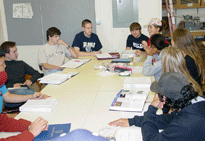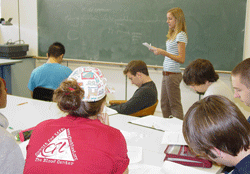Bioscience graduates
at Rice may pursue careers in medicine, patent law, or biological
research. They may become product managers, environmental consultants,
pharmaceutical representatives, technical writers, or biotech entrepreneurs.
Their education in finding and evaluating sources, critical thinking
and analysis, and designing and executing experimental protocols
prepares them for a multitude of careers.
“In
our small group, we aren’t afraid to share our ideas or questions. This
allows for more free thought and open discussion, which is
always more engaging and exciting.”
-Halle Rasmussen, a member of the BIOS 201 discussion group,
the cDNA Librarians. |
Integrating Communication in BIOS 202: 1999–2001
In
1999, faculty in Biochemistry & Cell Biology and Ecology & Evolutionary
Biology considered graduates’needs. Although the curriculum
strongly emphasized mastery of scientific concepts and technical
proficiency, the students had only a handful of opportunities for
scientific writing, most of them occurring in sophomore- through
senior-level labs. The departments collaborated with the Cain Project
to introduce writing into the beginning of most bioscience majors’ Rice
experience: the yearlong course BIOS 201/202: Introductory Biology.
In Introductory Biology, which enrolls approximately 150 per semester,
students read about related research and summarize the research
in short reports. To manage the large number of writers and papers
involved,
the Cain Project trains and supervises a team of talented upper-class
BIOS Writing Mentors. Writing Mentors participate in eight hours
of rigorous training that helps them prepare for mentoring students
and assessing papers. The mentors meet one-on-one with students
to help them locate sources, identify articles’ main points, structure
arguments, improve style, and meet the needs of specific audiences.
When the extra-credit writing assignments were first introduced
to BIOS 202 in 1999, newspapers could be used as sources. As
students demonstrated their depth of learning about cutting-edge
research,
faculty began to realize the value of the exercise. The extra-credit
papers became required and newspapers could no longer be used
as sources—students were expected to find and read primary journal
articles. With the help of BIOS Writing Mentors, students began to
read, understand, and communicate the scientific literature. It was
only a matter of time before writing would make its way into the
fall semester of Introductory Biology, BIOS 201.
Writing to Learn in BIOS 201: 2002–2004
In 2002, Dr. Mike Gustin introduced two writing assignments into
his fall course. Students read articles on a molecular aspect
of a human disease and wrote summaries to two carefully defined
audiences—first
physicians treating patients with the disease, then grandparents
with no background in biology. The assignments were valuable
|
![]()

